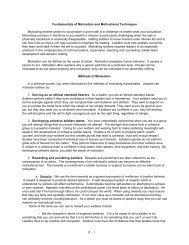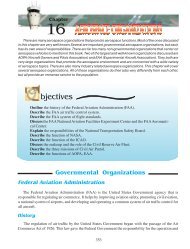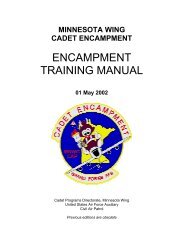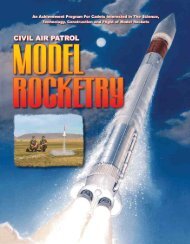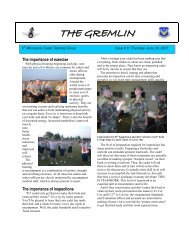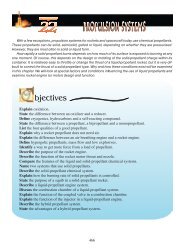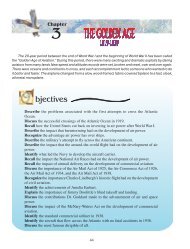14.5 Should the US Maintain the Nuclear Triad?By Dr. Adam B. LowtherOBJECTIVES:20. Name the components of the nuclear triad.21. Describe the background and intent of President Eisenhower’s “New Look” policy.22. Define the concept of “assured destruction.”23. In your own terms, relate the author’s stated reasons for keeping the nuclear triad in place.In the first week of Pres. Barack Obama’s new administration,the White House released his agenda, stating thepolicies the president will pursue regarding the nucleararsenal. The agenda includes three foci: securing loosenuclear material from terrorists, strengthening the NuclearNon- Proliferation Treaty, and moving toward a nuclear-freeworld. 1 Pushing the president in the directionof a “world without nuclear weapons” are such paragonsof past political power as former senator Sam Nunn andformer secretaries of state George Shultz and HenryKissinger. 2 Adding a host of Washington’s think-tank analyststo this list produces a crescendo of voices calling for“global zero.” They challenge not only the current size ofthe arsenal but also the very need for a nuclear triad.Much of the recent scholarship shows a clear preferencefor moving to a monad composed solely of submarinesarmed with submarine-launched ballistic missiles(SLBM) until the United States ultimately disarms. 3Some past and present members of the military leadershiphold a view that supports the nuclear arsenal. Seniorleaders have given a number of public speeches and interviewsoutlining what it will take to maintain and modernizethe most advanced and secure nuclear arsenal in theworld. 4 A key aspect of the general position held by supportersof the arsenal includes retaining the triad and replacingaging platforms.In the ongoing debate over the appropriate size and purposeof the nuclear arsenal, abolitionists—clearly in theascendency— make six basic arguments that would ultimatelylead to creation of a nuclear monad before reachingtotal disarmament: 51. Post–Cold War presidents have failed to alter nuclearpolicy for the current security environment.2. Terrorism, not Russia, is the primary threat facing theUnited States. Nuclear weapons do not deter terrorists.3. America’s advanced conventional capabilities can accomplishthe same objectives as nuclear weapons.4. As a signer of the Nuclear Non-Proliferation Treaty, theUnited States must move toward nuclear abolition.5. Only nuclear disarmament can overcome the threats ofaccidental detonation, miscalculation leading to nuclearwar, and proliferation of nuclear weapons and material.6. The safest and most secure leg of the nuclear triad isthe sea-based one. Thus, it should become the sole deliveryplatform for the nuclear arsenal. 6Admittedly, each of these arguments has some element oftruth; they do not, however, represent a complete understandingof the strategic role played by nuclear weaponsin ensuring the sovereignty of the United States or thespecific contribution of each leg of the triad. Althougheach of the abolitionists’ arguments deserves a detailedrefutation, a focus on the relevance of the triad must suffice.DEVELOPMENT OF THE TRIADIn 1947, the year the United States <strong>Air</strong> Force became anindependent service, the American military was attemptingto develop sound tactical, operational, and strategicdoctrine for the use of nuclear weapons. Just two yearsearlier, a new and devastating weapon had changed theface of warfare, but the full implications of the atombomb were yet to be realized. In a flurry of activity, theacademic, military, and policy communities undertookmuch writing and studying as the nation sought to understandnuclear weapons while also confronting the SovietUnion. As technology developed over the followingdecades, the nation moved from depending on a fleet oflong-range bombers as the sole method of delivering nuclearweapons (1945–59) to a nuclear triad composed ofbombers, intercontinental ballistic missiles (ICBM), andSLBMs. 7During the 1950s, Pres. Dwight Eisenhower believed thatan American effort to maintain conventional parity withthe Soviet Union would destroy the US economy andbankrupt the federal treasury. 8 Thus, his administration106
turned to the nuclear arsenal as a substitute for conventionalparity. In the president’s view, the United Statescould effectively deter Soviet aggression by placinggreater emphasis on nuclear weapons in American nationalsecurity policy. Commonly called the “New Look,”the president’s emphasis on the growth of advanced nuclearweapons and delivery platforms led to developmentof a large fleet of nuclear bombers and, by the end of theEisenhower administration, the nuclear triad. 9 Composedof three legs, the triad provides the United States withthree distinct delivery platforms for nuclear weapons.The first and oldest leg includes the nation’s long-rangebombers and their payload of gravity bombs and airlaunched cruise missiles. At its apex in the early to mid-1960s, Strategic <strong>Air</strong> Command included more than 1,300nuclear-capable bombers, including 700 of the then-newB-52s. 10 By 1990 the nation’s long-range bomber fleet haddeclined to 347 total aircraft. 11 Today, nuclear-capablebombers account for about half of the <strong>Air</strong> Force’s bomberfleet of 162 aircraft. 12A second leg became part of the nation’s nuclear arsenalin 1959 with deployment of the first six Atlas D ICBMs.Just three years later, the first Minuteman I deployed.Not until 1970 did America’s ICBM force reach its peakwith a mix of 1,054 Titan II and Minuteman I, II, and IIImissiles—most of which carried three to 12 warheads.These numbers remained constant until 1982. 13 Sincethen, the number of operationally deployed ICBMs hassteadily declined to its current size of 450. 14The addition of the Polaris SLBM in 1960 completed thetriad. Like the other two legs, SLBMs waxed at the heightof the Cold War and waned as it ended. By 1967 theUnited States had deployed 656 SLBMs aboard 41 ballisticmissile submarines (SSBN). When the Soviet Unioncollapsed in December 1991, the sea leg of the triad remainedlargely intact with 33 SSBNs carrying 608SLBMs. 15 Today, however, only 14 Ohio-class submarinesremain, each carrying 24 Trident II nuclear missiles.Throughout the Cold War, the United States maintained asubstantial inferiority in conventional military forces butenjoyed the protection of a sizable nuclear umbrella. Asthe Cold War progressed and American thinking aboutnuclear conflict developed, “assured destruction” tookprecedence as the approach of choice. Developed byThomas Schelling and others while he worked for theRAND Corporation in the 1960s, the concept of assureddestruction purposefully left the United States vulnerableto a first strike, yet the nation maintained a credible second-strikecapability. 16 Although nuclear policy evolvedthroughout the Cold War, its essential nature remainedmuch the same. Because of the exorbitant fiscal cost ofbuilding a large underground industrial infrastructure,for example, the nation chose to accept the risk of an unprotectedpublic—but only as long as it was defended bybombers standing at alert, ICBMs protected in their reinforcedsilos, and submarines quietly prowling the world’soceans. In the end, deterrence seems to have worked.A second aspect of American nuclear policy—often overlookedin the current debate— dates back to the earliestdays of the North Atlantic Treaty Organization (NA<strong>TO</strong>)when the United States and its European allies made aconscious decision to forgo creation of a NA<strong>TO</strong> militaryequal in strength to that of the Warsaw Pact. Instead, theEuropean members of NA<strong>TO</strong> chose to rely on America’sstrategic nuclear weapons— based in the United Statesand at sea— as well as tactical nuclear weapons, based inEurope, as a guarantor that Eastern Bloc troops wouldnot roll through the Fulda Gap on their way to Paris. 17 Extendeddeterrence, as it came to be known, enabled WesternEurope to focus on economic development instead ofheavy investment in national security. Although this typeof deterrence often proved unpopular with Europeanpublics, governments throughout Western Europe dependedupon the security provided by basing nuclearweapons throughout the West.ENTERING THE POST–COLD WAR ERAIn the immediate aftermath of the Cold War, assured destructionand related nuclear strategies that had servedthe nation well for more than two generations were almostforgotten as the euphoria that engrossed Americatook hold. 18 With it, the triad fell into decline. As the formerSoviet Union sought to stabilize its deterioratingeconomy by lowering its military expenditures, theUnited States joined Russia in making dramatic reductionsto the overall size of the nuclear arsenal. The “peacedividend” promised to the American people by presidentsGeorge H. W. Bush and Bill Clinton led to a refocusing ofUS foreign policy. With the Russian Bear focused on internalstruggles, the United States was free to take on therole of global hegemon and concentrate its efforts onserving as the world’s policeman. The 1990s saw the USmilitary intervene in a number of failing or failed statessuch as Somalia, Haiti, Bosnia, and Serbia, while also emphasizingdemocratization of the former Soviet Unionand globalization of the international economy. 19As Francis Fukuyama suggested in his article “The End ofHistory?” “What we may be witnessing is not just the endof the Cold War, or the passing of a particular period ofpostwar history, but the end of history as such: that is, theend point of mankind’s ideological evolution and the universalizationof Western liberal democracy as the final107
- Page 1 and 2:
VOLUME FOUR STRATEGIC PERSPECTIVESL
- Page 3 and 4:
VOLUME FOUR STRATEGIC PERSPECTIVESL
- Page 5 and 6:
VOLUME FOUR STRATEGIC PERSPECTIVESL
- Page 7:
VOLUME FOUR STRATEGIC PERSPECTIVESL
- Page 10 and 11:
12CHAPTER 12INTRODUCTION TO STRATEG
- Page 12 and 13:
12.1 Strategic Leadership: Defining
- Page 14 and 15:
mandates or resolutions that would
- Page 16 and 17:
and ambiguity, aspiring strategic l
- Page 18 and 19:
12.2 National Security StrategyThe
- Page 20 and 21:
within our borders has always been
- Page 22 and 23:
front common challenges like violen
- Page 24 and 25:
and our strategy, not sector earmar
- Page 26 and 27:
thinking about organizations. She m
- Page 28 and 29:
A systemic approach to failure is m
- Page 30 and 31:
The late W. T. Grant Company is a r
- Page 32 and 33:
the resources - setting the directi
- Page 34 and 35:
focal point for describing and inte
- Page 36 and 37:
Consequently, we do not restrict th
- Page 38 and 39:
paragraphs, Web pages, then edit an
- Page 40 and 41:
Web, can be viewed as a CS attempt
- Page 42 and 43:
How to evaluate users and contribut
- Page 44 and 45:
13CHAPTER 13LEADING PUBLIC &VOLUNTE
- Page 46 and 47:
13.1 Leadership for Volunteers:The
- Page 48 and 49:
13.2 Take Root: Volunteer Managemen
- Page 50 and 51:
QualificationsClearly list educatio
- Page 52 and 53:
and effectively track their volunte
- Page 54 and 55:
• Understand rules for recognitio
- Page 56 and 57:
• Send a birthday card.• Submit
- Page 58 and 59: and tested more than six decades af
- Page 60 and 61: specific interests of the donors, v
- Page 62 and 63: tain) tax-exempt status from the In
- Page 64 and 65: Smucker, 1999).The Internal Revenue
- Page 66 and 67: culture is necessary to ensure the
- Page 68 and 69: 13.4 The New Look of TransparencyBy
- Page 70 and 71: ees for a couple of reasons: One, i
- Page 72 and 73: 13.5 Public and Private Management:
- Page 74 and 75: TABLE 1:FUNCTIONS OF GENERAL MANAGE
- Page 76 and 77: 3. Career System. The model corpora
- Page 78 and 79: islative charter - the Clean Air Ac
- Page 80 and 81: In controlling performance, Chapin
- Page 82 and 83: 14CHAPTER 14AIRPOWER ASSTRATEGIC LA
- Page 84 and 85: 14.1 Strategic Air Power: Fulfillme
- Page 86 and 87: carry it out. Their daylight raids
- Page 88 and 89: you did not rely on strategic bombi
- Page 90 and 91: 14.2 Warden and the Air Corps Tacti
- Page 92 and 93: ecomes one of applying sufficient i
- Page 94 and 95: tification, and a Jominian claim to
- Page 96 and 97: courage the rapid and widespread ex
- Page 98 and 99: it to influence physical players in
- Page 100 and 101: 14.4 Basic Air Force DoctrineAF Doc
- Page 102 and 103: earthquake-stricken Haiti. The worl
- Page 104 and 105: perspective. Airmen do not divide u
- Page 106 and 107: Command and ControlCommand and cont
- Page 110 and 111: form of human government.” 20 Dem
- Page 112 and 113: obtainable goal. See the Global Zer
- Page 114 and 115: 15CHAPTER 15ORGANIZATIONAL CULTURE
- Page 116 and 117: 15.1 Organizational CultureBy Doria
- Page 118 and 119: Review. This action strives to unco
- Page 120 and 121: gram will serve and then having the
- Page 122 and 123: ticipating the changes being made b
- Page 124 and 125: Many years of working with change p
- Page 126 and 127: At the least, the areas of concern
- Page 128 and 129: 15.4 Developing an Innovative Cultu
- Page 130 and 131: CONCLUDING THOUGHTSIn an ever-chang
- Page 132 and 133: global issues. Businesses that poss
- Page 134 and 135: — Sees the big picture—the shif
- Page 136 and 137: 16CHAPTER 16STRATEGIC COMMUNICATION
- Page 138 and 139: 16.1 Principles of Strategic Commun
- Page 140 and 141: 16.2 The Art of NegotiationBy Brend
- Page 142 and 143: 16.3 Negotiating Effectively Across
- Page 144 and 145: hidden areas can act as cultural ho
- Page 146 and 147: and four conflict styles. Hammer be
- Page 148 and 149: maintaining the relationship. As th
- Page 150 and 151: 25 Mitchell R. Hammer, “Chapter 1
- Page 152 and 153: tural, socioeconomic, and psycholog
- Page 154 and 155: for the win-win," during which time
- Page 156 and 157: interests and, at worst, as a gun s
- Page 158 and 159:
Public diplomacy is surely about mu
- Page 160 and 161:
But public diplomats do not have th
- Page 162 and 163:
Photo courtesy of the familyThe LEA
- Page 164:
THE CADET OATHI pledge that I will



